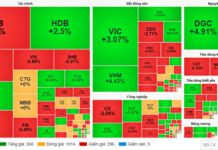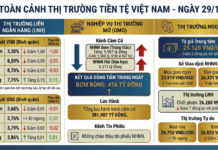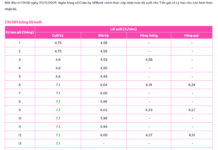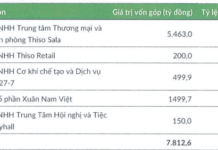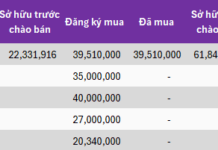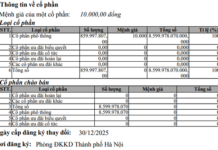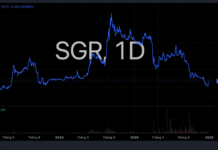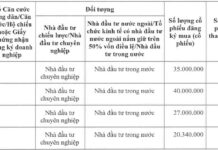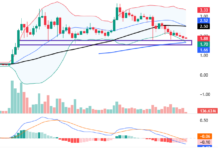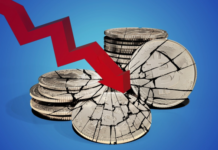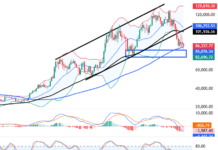Banks are aggressively mobilizing capital through deposit certificates with higher interest rates than regular savings accounts. The market is concerned that this could lead to a wave of rising interest rates, causing an increase in banks’ input costs and subsequently affecting lending rates.
The Race for Deposit Certificates
Sacombank, a joint-stock commercial bank, has recently issued deposit certificates worth VND 5,000 billion, with a 7-year term and an interest rate of 7.1% fixed for the first year. The interest rate for subsequent years will be adjusted flexibly according to the market.
Sacombank’s deposit certificates have a face value of VND 1 million each. The principal is paid in a lump sum at maturity, while interest is paid annually. Notably, buyers of Sacombank’s deposit certificates can withdraw a portion or all of their capital before maturity, and the certificates can be transferred or pledged as collateral for loans at preferential interest rates…
Similarly, PVcomBank, a joint-stock commercial bank, has also issued deposit certificates for individual customers, offering a fixed interest rate of 8% per annum and a term of up to 85 months. Notably, PVcomBank’s deposit certificates have a minimum face value of VND 10 million, and interest is paid monthly instead of annually as usual. This means that after receiving monthly interest, the owner of the deposit certificate can continue to save it to earn additional interest. Effectively, the actual interest rate for PVcomBank’s deposit certificate buyers is higher than the 8% rate set by the bank.
In parallel with issuing deposit certificates, many banks are also planning to increase deposit interest rates after a period of lowering them. According to incomplete statistics, since the beginning of September, at least six commercial banks have increased interest rates on short-term deposits. Most recently, Agribank raised interest rates on 1-2 month term deposits by 0.2 percentage points to 2% per annum; online savings rates for 3-5 month terms increased by 0.3 percentage points to 2.5% per annum; and rates for 6-9 month terms were slightly adjusted upwards by 0.1 percentage points to 3.3% per annum.
The latest analysis report from MBS Securities Joint Stock Company points out that the reason for the increase in deposit interest rates and the attraction of capital through channels such as high-interest deposit certificates is to enhance the competitiveness of savings compared to other investment channels. The MBS analysis team believes that the increase in deposit interest rates is also due to the continued growth of credit as capital demand tends to accelerate in the last months of the year.

Customers Concerned About Rising Borrowing Rates
With the news of rising deposit interest rates, some individuals who have borrowed or are planning to borrow money from banks for purchasing homes, consumption, or business purposes are concerned about a potential increase in lending rates in the future.
Regarding this issue, Mr. Tran Tan Loc, Vice Chairman of the Board of Directors of Eximbank, shared that the decision to adjust lending rates depends on the capital structure of each bank. If credit demand increases significantly, banks will have to offer higher interest rates on long-term deposits to attract depositors or anticipate future market trends. “Whether lending rates increase or not depends on the bank’s input costs. For example, if a bank raises long-term deposit rates but simultaneously attracts a large volume of non-term deposits at low rates, its input costs remain unchanged, and lending rates can be stable. Conversely, if a bank needs long-term capital and can only attract high-interest deposits without access to softer capital channels, its input costs will rise, leading to an increase in lending rates,” Mr. Loc explained.
Mr. Tran Minh Hoang, Director of Research and Analysis at VCBS, a securities company, predicted that deposit interest rates could continue to rise to maintain the attractiveness of VND but would not trigger a rate race as the economy’s credit absorption remains slow. As a result, VCBS expects lending rates to remain relatively stable in the second half of 2024. However, there will be variations in lending rates depending on industries and the risk appetite of individual banks.
From another perspective, financial and banking expert Nguyen Tri Hieu raised concerns about banks increasing deposit interest rates or issuing high-interest deposit certificates when credit growth is not robust. He suggested that this could be due to a rise in non-performing loans, with some banks unable to recover their capital, leading to a slight decline in liquidity. As a result, they may need to offer higher interest rates to attract deposits and stabilize cash flow, potentially increasing their operating costs and subsequently lending rates.
At a recent regular government press conference, Mr. Dao Minh Tu, Permanent Vice Governor of the State Bank of Vietnam, assessed that while deposit interest rates have increased, lending rates have decreased, indicating that commercial banks have shared the burden with businesses. Despite higher deposit rates, lower lending rates have narrowed the gap between input and output costs for banks.
Real Estate Credit Growth
From a state management perspective, Mr. Nguyen Duc Lenh, Deputy Director of the State Bank’s Ho Chi Minh City Branch, said that in the first seven months of 2024, overall credit growth in the city reached 3.9%, while real estate credit growth was 5.5%. Notably, housing loans (including social housing, commercial housing, and other types of housing) accounted for the highest proportion, approximately 57% of total real estate credit in the city. Social housing loans increased by 78% compared to the end of 2023 as banks accelerated disbursements for social housing projects in the area. Credit for real estate production and business activities, such as infrastructure development for industrial parks and export processing zones, and construction of offices, skyscrapers, restaurants, hotels, and tourist areas, also achieved significant growth rates. “These results in real estate credit activities are in line with the market’s growth trend. Therefore, some banks are attracting more deposits to implement their lending plans and boost loan growth in all sectors,” said Mr. Lenh.


